Violence Project Policy Problem
When a friend makes a mistake, you kindly nudge them back into a more rational mode.
That is what I am doing now for the Violence Project.
The Violence Project, Before and Now
Gun Facts has been both a fan and a friend to the Violence Project. In their beginning, they were like us: data butlers who did not make policy recommendations. Their resources (much more than the Gun Facts project has or will ever likely receive) allowed them to gather an incredible amount of detailed information about mass public shooting (MPS) events and perpetrators.
We also have helped the Violence Project. During a periodic update of the Gun Facts Mass Public Shooting database, we identified three such events in our database that were missing in theirs. So, we sent emails with pertinent details, and they responded with kindness and gratitude.
But in recent times, we have noticed that they are both taking policy positions and employing common propaganda phrasing. This trend risks removing the Violence Project from a role of providing data that allows people to make up their own minds, to being an activist organization.
The latter role would be a shame as it would, at minimum, stain their reputation, and at worst destroy their credibility. This article [penned by Gun Facts founder Guy Smith] is a friendship nudge that will hopefully guide them back to a more academic path.
The Violence Project Email
We received an email from the Violence Project (VP) which was distressing due to incautious language that divorced the organization from unquestioned neutrality, and it pronounced sins on others that they then committed themselves. To understand this situation in full, I’ll document where they missed the boat, by how much, and why it is important.
“Critics often point to the 1994 federal Assault Weapons Ban and claim it ‘didn’t work.’ That misreads the evidence. The ban was short-lived and riddled with loopholes, but it reduced the use of assault weapons in crime.”
Let’s break down this clustered claim:
Critics: They did not name the critics, so it is impossible to cross check. But that summary is painfully close to this quote, “… we cannot clearly credit the ban with any of the nation’s recent drop in gun violence.”
Who said that? It was in a federal government review of the 1994 “ban” conducted by the National Institute of Justice. 1 This was no lightweight analysis. And though their phrasing was cautious, their conclusion was that no measurable cause and effect existed between the “ban” and changes in crime.
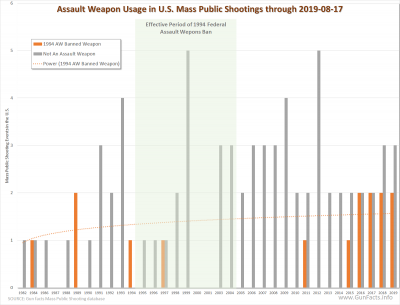 Where the writer at VP may have gotten confused is that there was a lull in violence, and in MPS during the “ban.” This lull included entire years without MPS. Yet there were MPS events including the Columbine massacre, with and without assault weapons. The lull created an artificial lowering of death rates unrelated to assault weapon manufacturing, purchases or existing stockpiles.
Where the writer at VP may have gotten confused is that there was a lull in violence, and in MPS during the “ban.” This lull included entire years without MPS. Yet there were MPS events including the Columbine massacre, with and without assault weapons. The lull created an artificial lowering of death rates unrelated to assault weapon manufacturing, purchases or existing stockpiles.
Loopholes: They left this assertion undefined, but we have to accept that the 1994 Federal Assault Weapons Act was poorly constructed (and since its author, Dianne Fienstein, was my senator, I get to pick on her). The “ban” didn’t focus on functionality. Two rifles could have the same cycle rate (number of bullets per minute), accept the same capacity magazines, have equal muzzle energy and velocity, and yet one would be an ”assault weapon” and the other would not. For example, the Rugar Mini-14 Ranch (not an assault weapon) has identical functionality to the Mini-14 Tactical (some variants were an assault weapon). Both were available before 1994.
This is the first point of propagandist language VP exposed in their email. “Loophole” is a “scare word,” one that invokes distrust and fear. Since the 1994 legislation was not “riddled with loopholes” but was simply dumb in its design, the use of this phrase likely had an intended purpose, and not an honest one.
Crime reduction: They also did not disclose how they came to the conclusion that the law “reduced the use of assault weapons in crime.” If they referred to the same study I mentioned above, then they concluded incorrectly.
The Institute of Justice study looked at ATF traces of weapons during that period, but there are two problems therein.
 The first, and the big one, was that the nation was exercising a massive backlash to violent crime that had risen strongly through the 1970s and 1980s. Between 1993 and 1996, 24 states, with more than half of the country’s population, passed habitual offender laws. This legislation had direct and dramatic effects on crime rates.
The first, and the big one, was that the nation was exercising a massive backlash to violent crime that had risen strongly through the 1970s and 1980s. Between 1993 and 1996, 24 states, with more than half of the country’s population, passed habitual offender laws. This legislation had direct and dramatic effects on crime rates.
And it likely had an effect on the number and types of guns traced by the ATF.
The other issue is all the known problems with ATF traces. Not all guns are traced. Many guns not used in crimes are traced. Police at the local level might not know an assault weapon from a generic boom stick. Trace data is a weak proxy. When paired with a falling crime rate due to a variety of early 1990s-era “get tough on crime” laws, the conclusions that VP might be making are not sound.
“When [the 1994 act] expired, the deadliest attacks in U.S. history — from Sandy Hook to Uvalde to Las Vegas — followed, all carried out with these weapons.”
Their statement is quite a bit misleading and solidly propagandist (did you know I wrote a book on propaganda analysis?).
Foremost, the statement is wrong. There have been MPS with high body counts (Virginia Tech, 32 dead, 2007) involving only handguns after the law expired in 2004. And naturally, any statement using words like “all,” “always,” or “never” are immediately dismissible.
We at Gun Facts have established that, at least in terms of MPS, there are other factors aside from weapon choice. This is not to say weapons and accessories don’t matter. But other factors are involved when it comes to the degree of “deadliness” of MPS events.
 To start off this review and gain a high level perspective, it is good to look at the number of MPS committed with and without assault weapons. As you likely already know, most MPS do not involve assault weapons at all.
To start off this review and gain a high level perspective, it is good to look at the number of MPS committed with and without assault weapons. As you likely already know, most MPS do not involve assault weapons at all.
More importantly, as the number of people killed in these events rises, they all become one-off events committed by “super killers,” people aching to get a high score on the MPS roster. On this chart, we see that the super killer events make up 9% of all such events.
Even if all of the “deadliest attacks in U.S. history” had been committed with assault weapons (which they were not), they make up a fraction of MPS, and MPS make up a fraction of gun homicides. VP’s claim is more alarmist than informative.
Since super killer events include ones where assault weapons were and were not used, and since low body count MPS involve assault weapons, the question then becomes “what are the other variables that might explain higher death rates?” Gun Facts has identified two variables that are often interrelated, and which make a big difference.
First is planning. Well-planned MPS tend to be more deadly because the perpetrator has made decisions concerning how to kill more people. This doesn’t always work, as demonstrated by an attempted MPS event at a church/school where despite planning, the perp did not anticipate the doors being locked (he shot through the window out of desperation and killed “only” two children).
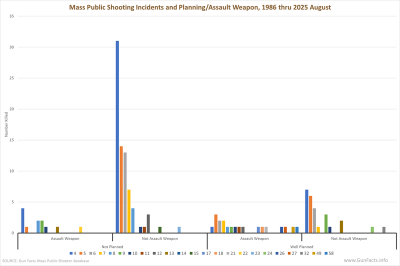 |
 |
When we combine planning and weapon type used, we see two interesting things. First, unplanned events skew to lower body counts regardless of weapon type. Second, well-planned events involving assault weapons are very evenly distributed by the number of people killed, though this is less true for non-assault weapons. Planning (which includes weapon selection) has a strong bearing on MPS effectiveness.
Yet the VP email laid the blame only on weapon type.
To make this picture a little clearer, if we look at the average number of people killed in MPS incidents, we see that there is a marginal increase in the death rate for assault weapons when the event is unplanned. We also see that the death rate for MPS rises for well-planned events regardless of weapon type. But the combination of planning and use of an assault weapon does significantly increase the number of people killed.
The next factor is what the Gun Facts project calls “cattle pen scenarios” (well, I named it such because I worked on a ranch when I was young and have intimate insight into how cattle pens operate). Our definition of a cattle pen scenario is a MPS event where:
- Victims are packed into a confined area with one or both of the following:
- Few or narrow exists for escape
- Few or no barriers to seek cover behind
The mother of all cattle pen scenarios was the Las Vegas country music massacre.
- A venue designed for 22,000 people
- 22,000 tickets were sold (assume some no-shows and people being late)
- Using my body dimensions (and I’m lean) 22,000 would be chest to back, shoulder to shoulder
- Exits were few and narrow for ticketing and security
- Only barricades were the stage and a few vending booths
Yes, the perp had exotic accessories (bump stocks, drum magazines) for his assault weapons, but he also had a herd of victims for which marksmanship was unnecessary.
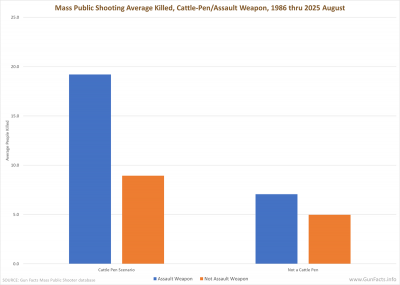 |
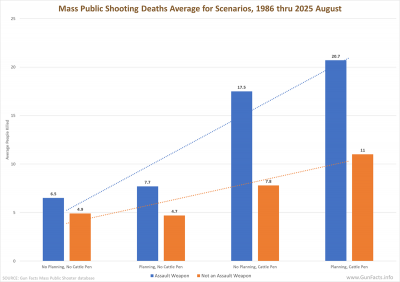 |
Taking the average number of people killed at MPS, we see that when an incident is not a cattle pen scenario, the degree of death between assault weapons and non-assault weapons is negligible. But the difference is nearly double when it is a cattle pen.
Just like weapon choice, venue selection is part of planning. There have been a number of MPS manifestos and notes left by intercepted MPS candidates that clearly communicated they wanted a cattle pen. In some cases, perpetrators created or amplified such scenarios (the Virginia Tech perp chained doors shut to ensure cattle penning).
The point thus far is that VP bluntly blamed just the weapon type without asking the very basic question of what other variables might be at play when it comes to MPS deadliness. VP’s data collection is great, but their analysis is distressingly poor.
But allow me to drive that point mercilessly home.
When we combine weapon type, planning and venue selection (cattle penning), we see a body count escalation through the combination of factors and not just weapon type.
Without planning or selecting/creating a cattle pen scenario, assault weapons barely have a 30% advantage (and there may be other variables we have not fully explored that create this difference). The highest spread (224%) is for unplanned events that were cattle pens.
But the gap between no planning plus no cattle pen and planning plus cattle pen is a huge 422%.
Understand the difference: 33% delta without these two complicating variables, and 422% with both of them.
“Limiting magazine capacity to 10 rounds forces shooters to reload more often, creating critical moments for escape or intervention.”
Long ago we dove into “large capacity magazines” (LCM) and mass public shootings, and found poor correlations. Click the link for the full report, but the summary is that magazine capacity is not a great determinate variable.
Note the bell curve on the left of this chart and how LCMs are well represented along with standard capacity magazine for low body counts.
Why? The cattle pen scenario is the big driver. There was a bank shooting in Florida where the perpetrator came armed with an assault weapon and “jungle clips,” pairs of 30 round magazines taped together such that rapid reloading is possible. The results? Just enough people killed to be classified a MPS. The bank was largely empty when he entered.
The reloading claim is pretty flimsy in general. A lightly practiced shooter (just a few repetitions at the range) can swap magazines in 2.5–4 seconds, and that is under stress conditions. But mildly practiced shooters often swap AR-15 magazines in 1.5–3 seconds. 2 In short, the process is fast. Restricting access to just 10-round magazines will have little effect.
Case: Investigators of the Virginia Tech incident found at least 17 empty magazines at the scene and estimate over 170 rounds were fired. That equates to basically 10-round magazines, though his handguns (yep) were designed for up to 15-round mags. He had plenty of time (2–4 seconds) for each magazine swap.
VP’s assertion is made without perspective. As such, it is an unfounded opinion and certainly not a fact.
“Too often, this debate cherry-picks evidence.”
The irony.
We have established that the VP’s copywriter (at the very least) is in propaganda mode, not public education. Ignoring confounding variables while declining in depth analysis could be written off as sloppiness. But when they continue with prose like “for the families who bury children” and “the holes in our policy ‘Swiss cheese’ are killing people. It is time to close them,” they escape into advocacy and agitprop.
I’m being relatively restrained with my critique here. In their early days, their data butler era, VP was much like Gun Facts: we both wanted to add as much clarity via data as we could so an adult discussion of gun violence could be had. Because of their noble beginnings, I’m cutting them a lot of slack… for now. I hope they revert to their former M.O. and add quality information, and not malformed opinion, to public discussion.

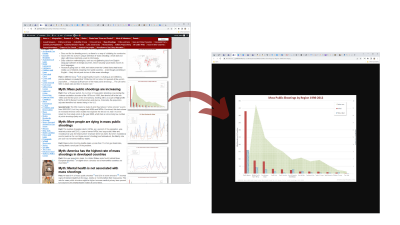
Its time to face reality, a significant number of these so-called gun violence/gun safety groups do not have facts as their primary goal/tool but are willing to use what ever methods are available to attack the Natural Rights of law-abiding citizens.
As most in multi-level marketing have heard “Facts tell, Stories sell.”
Cherry picking and outright lies are their prime tools IMHO!